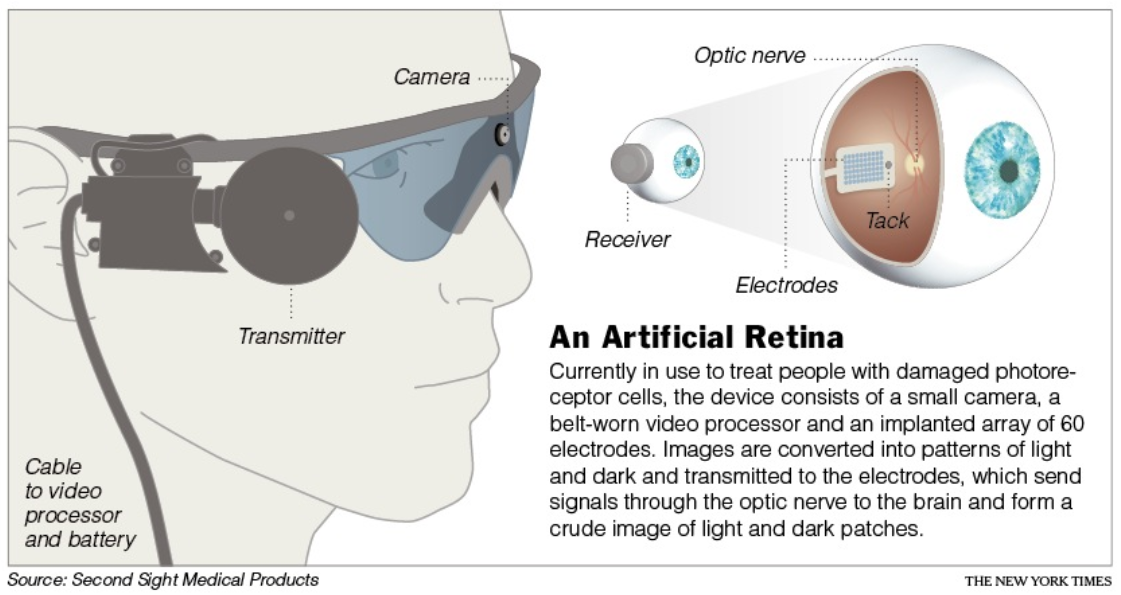Week 5 - Assistive Devices and Prosthetics
Prosthetics have been around for centuries! While we don't have the cool prothetics from things like Star Wars, we do have really cool prothetics even at this time.
Enabling Technologies
Enabling Technologies are those that make people more capable than they would be without the techno-assistance. For instance, GPS helps make you more capable of traversing (unknown) terrain.
Assistive Devices
Assistive Devices are used by individuals with some degree of disability to perform functions that would be otherwise impossible or difficult to achieve. Examples include:
- Eyeglasses
- Contact lenses
- Hearing aids
- Crutches
- Wheelchairs
- ...
These are usually palliative, where they treat a potentially incurable condition rather than finding the cure itself.
Prosthetics
Prosthetics are assistive technologies that replace a missing or impaired part of the body. They attempt to treat the cause of the disability rather than reduce symptoms of it.
We'll look at just these two categories (assistive devices and prosthetics) for this week.
Case Study: Cochlear Implant
Most hearin lost is usually irreversible, namely sensorineural hearing loss. The ear cannot generate the electrical signals to send to the brain. Around 8000 children in the US are born each year with this condition. This can only be treated with a cochlear implant. Even more children lose their hearing from infection as a rare side effect of medications.
It's important to note that deaf culture and language is rich and meaningful, so some choose not to get this implant to keep this culture.
Customizable Hearing Aids
Most people who suffer hearing loss are not profoundly deaf. They can hear sound, but have lost sensitivity to them. There are hearing aids that allow the user to customize the intensity of sounds around them. Consider this scenario described by Farhad Manjoo.
Case Study: Retinal Implant
Retinosa Pigmentosa is a disease that destroys the light-receptive rods and cones in the retina. As they die off, vision will narrow in until there's nothing seeable anymore, making them permanently blind. This affects about 1.5 million people worldwide (1 in 4000).
Often, these people have fully functioning optic nerves. However, they have no ability to sense light. This is similar to how those that lose their hearing may still have a fully functioning auditory nerve.
Using a device similar to a cochlear implant, researchers are able to restore some degree of sight to patients of this disease.

Case Study: Prosthetic Legs
Dr. Herr, a researcher at MIT who lost his legs in a climbing accident, designed a prosthetic leg. He lead a movement to help amputees return to activities that were lost along with missing limbs. While his devices are expensive and powerful, the rest of the industry has made less expensive ones that don't require as much battery power.
Similar technologies allow us to build advance exoskeletons, allowing paraplegics to walk.
For more on prothetics, see AOPA IN Advance SmartBrief.
Case Study: Prosthetic Arms
While prosthetic legs are rapidly adapting, prosthetic arms have more complications and are harder to design and build. Consider the plight of this Army Veteran
Mike Kacer unlaces his worn-out combat boots. Practicing with his mechanical left arm, he maneuvers two silver pincers, oversized tweezers that tug his laces loose. It does not go well.
Lacing up his shoes is even harder. “I could actually tie the shoe faster without the prosthesis,” the Army veteran says.
Despite practicing with this artificial arm — and with more than a dozen other Army-issued prosthetic limbs at his disposal — Kacer said that most of the time he doesn’t wear the devices. That’s true even though the government has probably spent more than $117,000
to provide him with artificial arms over the past five years. One of the more sophisticated devices he owns cost more than $100,000, and it’s a device he doesn’t often use.
“If I had to put a timeframe on it,” he says, in “a 13-hour day I probably wear a prosthetic four to five hours out of it.”
The Bionic Arm
Learn why one wouldn't want to wear their prosthetic limb. The problem is that:
- There's more demand for legs than arms (since more people lose legs)
- Recreating a hand is very complicated and difficult to recreate.
Sensory Feedback
There a many functions though that require we send feedback signals back to where the arm once was. Currently, prosthetic arms don't have the ability to sense and communicate things like texture, temperature, or proprioception (the sense of coordination or spatial relationship between parts of the body needed for movements). However, engineers are currently designing the sensors, materials, and communication pathways that will allow sensory feedback.
The last challenge is to connect sensors on the prosthetic arm to the sensory nerve of the limb via neuromuscular interfacing. The nerves in the arm get exposed, and are wired to electrodes that send nerve signals to the actuators of the arm. The sensors in the arm are connected back to the sensory nerves used to transmit sensation from the patients own fingers.
A similar technology allows a paraplegic to control the movement of his hand again.
What's Next
See Cal Poly's Empower Club if you were motivated by these examples of prothetics to help the local community out!